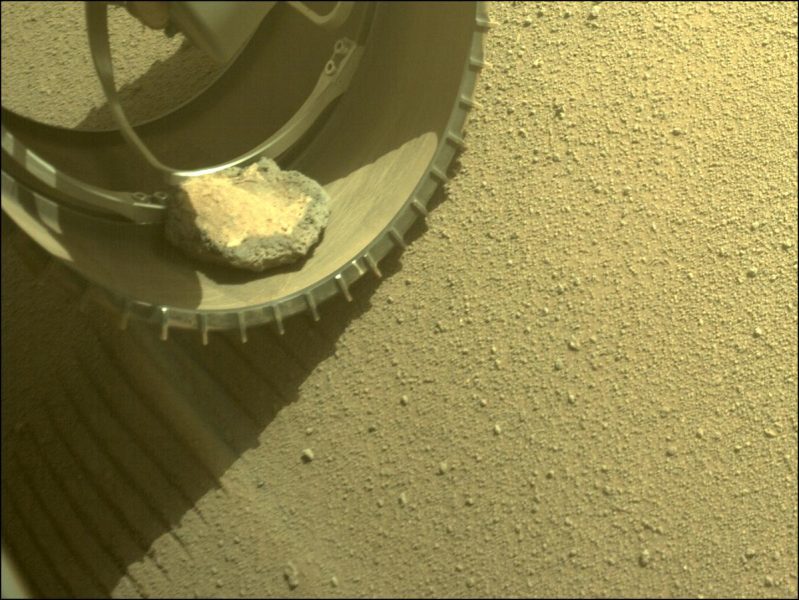
This 'pet' rock goes wherever Mars rover Perseverance goes
"In early February, a rock found its way into the rover’s front left wheel, and since hitching a ride, it’s been transported more than 5.3 miles. This rock isn’t doing any damage to the wheel," NASA said.

The National Aeronautics and Space Administration’s (NASA) Mars rover Perseverance has had an unexpected travelling companion for the past four months – a ‘pet’ rock, the US space agency has said.
In an update on its Mars 2020 Perseverance mission, NASA said that the rock has travelled more than 8.5 km, settling itself into the rover’s front left wheel.
The Federal’s award-winning interactive: NASA’s Mars mission at a click
“In early February — a rock found its way into the rover’s front left wheel, and since hitching a ride, it’s been transported more than 5.3 miles (8.5 km). This rock isn’t doing any damage to the wheel, but throughout its (no doubt bumpy!) journey, it has clung on and made periodic appearances in our left Hazcam images,” NASA said.
This is not the first time a rock has hitched a ride on a Mars rover mission. Some 18 years ago, a “potato-sized” rock found its way into the Spirit rover’s rear right wheel, and had to be dislodged, it added.
Also read: A home in Mars: IISc, ISRO researchers develop space bricks technique
According to NASA, it is unclear exactly how long these rocks stuck around and they tended to hop off after a few weeks. Perseverance’s current companion is therefore on its way to setting Mars hitch-hiking records.
“If this pet rock could talk, it might tell us about the changes it has noticed as we travelled back north through the Octavia E. Butler landing site, and then west, passing the spectacular remains of the former extent of the delta, “Kodiak,” on our journey to the western Jezero delta. We’re now in the Delta Front Campaign, and we just abraded what might be our first sedimentary rock. Perseverance’s pet rock is now a long way from home,” Eleni Ravanis, Student Collaborator at the University of Hawaiʻi at Mānoa, wrote on the NASA website.
Also read: Mars had ponds & rivers, now it’s turning dry; study explains unusual reasons
Where will the ‘pet’ rock journey end?
“It’s possible that the rock may fall out at some point along our future ascent of the crater rim. If it does so, it will land amongst rocks that we expect to be very different from itself. As one of our team members quipped this week,” said NASA.
In last September, Perseverance had completed the collection of the first sample of Martian rock, a core from Jezero Crater slightly thicker than a pencil. This was hailed as a “truly historic moment”. The sample-taking process began on September 1, when the rotary-percussive drill at the end of Perseverance’s robotic arm cored into a flat, briefcase-size Mars rock nicknamed “Rochette.”
“NASA has a history of setting ambitious goals and then accomplishing them, reflecting our nation’s commitment to discovery and innovation. This is a momentous achievement and I can’t wait to see the incredible discoveries produced by Perseverance and our team,” NASA Administrator Bill Nelson had said then.
“For all of NASA science, this is truly a historic moment,” said Thomas Zurbuchen, associate administrator for science at NASA Headquarters in Washington.
Car-sized rover
Perseverance landed on the Red Planet on February 18, 2021. It is car-sized, about 10 feet long (not including the arm), 9 feet wide, and 7 feet tall (about 3 metres long, 2.7 metres wide, and 2.2 metres tall). But at 2,260 pounds (1,025 kilograms), it weighs less than a compact car. In some sense, the rover parts are similar to what any living creature would need to keep it “alive” and able to explore.
Also read: This June, you can witness a rare planet parade of ‘Fab Five’
A key objective for Perseverance’s mission on Mars is astrobiology, including the search for signs of ancient microbial life. The rover will characterise the planet’s geology and past climate, and pave the way for human exploration of the Red Planet.
The Mars 2020 Perseverance mission is part of NASA’s Moon to Mars exploration approach.

